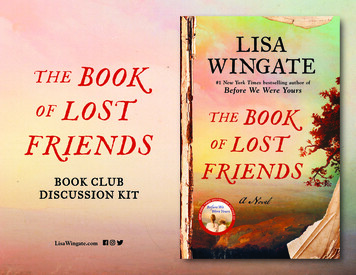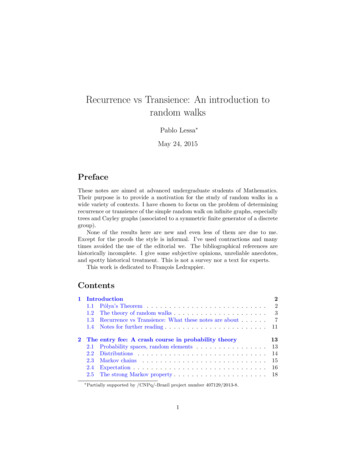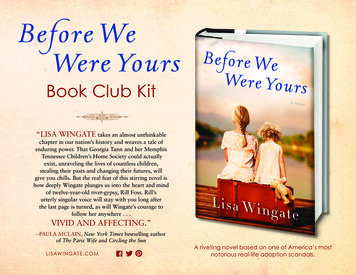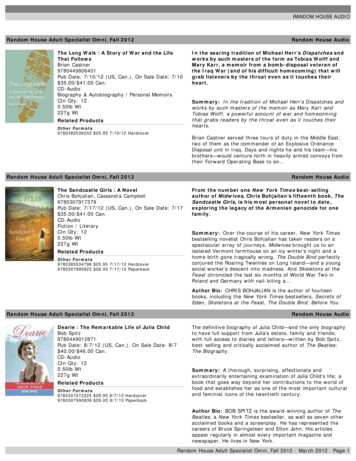
Transcription
BOOK CLUBDISCUSSION KITLisaWingate.comi
A Note from Lisa WingateEach time a new book enters the world, it seems as though the most oftasked question is: How did this story come to be— what inspired it? I’mnot sure what this process is like for other writers, but for me there isalways a spark, and it is always random. If I went looking for the spark, I’dprobably fail to find it.I never know when it will come my way or what it will be, but I feel itinstantly when it happens. Something consuming takes over, and a daythat was ordinary . . . suddenly isn’t anymore. I’m being swept along on ajourney, like it or not. I know the journey will be long and I don’t knowwhere it will lead, but I know I have to surrender to it.The spark that became Hannie’s and Benny’s story came to me in the mostmodern of ways—via an email from a book lover who’d just spent timewith the Foss family while reading Before We Were Yours. She thoughtthere was another, similar, piece of history I should know about. As avolunteer with The Historic New Orleans Collection, she’d been enteringdatabase information gleaned from advertisements well over a centuryold. The goal of the project was to preserve the history of the “LostFriends” column, and to make it accessible to genealogical and historicalresearchers via the Internet. But the data-entry volunteer saw more thanjust research material.“There is a story in each one of these ads,” she wrote in her note to me.“Their constant love of family and their continued search for loved ones,some they had not seen in over 40 years.” She quoted a line that had struckher as she’d closed the cover of Before We Were Yours:“For the hundreds who vanished and the thousands who didn’t.May your stories not be forgotten.”She directed me to the “Lost Friends” database, where I tumbled downa rabbit hole of lives long gone, stories and emotions and yearningencapsulated in the faded, smudged type of old-time printing presses.Names that survived perhaps nowhere beyond these desperate pleasof formerly enslaved people, once written in makeshift classrooms, atkitchen tables, and in church halls . . . then sent forth on steam trains andmail wagons, on riverboats and in the saddlebags of rural mail carriers,destined for the remote outposts of a growing country. Far and wide, themissives journeyed, carried on wings of hope.In their heyday, the “Lost Friends” ads, published in the SouthwesternChristian Advocate, a Methodist newspaper, went out to nearly fivehundred preachers, eight hundred post offices, and more than fourthousand subscription-holders. The column header requested thatpastors read the contents from their pulpits to spread the word of thoseseeking the missing. It also implored those whose searches had endedin success to report back to the newspaper, so that the news might beused to encourage others. The “Lost Friends” advertisements were theequivalent of an ingenious nineteenth-century social media platform, ameans of reaching the hinterlands of a divided, troubled, and fractiouscountry still struggling to find itself in the aftermath of war.I knew that very day, as I took in dozens of the “Lost Friends” ads, meetingfamily after family, searcher after searcher, that I had to write the storyof a family torn apart by greed, chaos, cruelty, despairing of ever againseeing one another. I knew that the “Lost Friends” ads would providehope where hope had long ago been surrendered.1
A Note from Lisa WingateHannie began speaking to me after I read this ad:I knew that Hannie’s situation would, in some ways, be directed by thelife of Caroline Flowers, who wrote the ad, but that Hannie’s search wouldlead her to strike off on a quest. Her journey would be life-altering, anodyssey of sorts. It would change her forever, redirecting her future.For the purposes of Hannie’s age and the particularly lawless, perilouspostwar era in Texas, I reimagined history a bit, setting the story in 1875,ten years after the ending of the war. While separated families had beenplacing ads in various newspapers since the war’s close, distribution ofthe “Lost Friends” column actually sprang to life in 1877 and continuedthrough the early part of the twentieth century.I hope you felt the connection to Hannie’s and Benny’s stories as muchas I felt the connection to them while writing about them. They are, inmy view, the sort of remarkable women who built the legacies we enjoytoday. Teachers, mothers, business owners, activists, pioneer farm wives,community leaders who believed—in some large or small way—that theycould improve the world for present and future generations. Then theytook the risks required to make it happen.May we all do the same in whatever way we can, in all the places we findourselves.And may this book do its part, whatever that part might be.—Lisa Wingate2
Discussion Questions1.2.L isa Wingate brings to life stories from actual “Lost Friends”advertisements that appeared in Southern newspapers afterthe Civil War, as newly freed slaves desperately searched forloved ones who had been sold away. Had you heard of thereal “Lost Friends” ads before? What did you think of thewords written so long ago? What did you learn about theReconstruction era through this novel?Th e Book of Lost Friends is a story of remarkable women whobuilt legacies we benefit from today. There are many womenfrom the past, like Hannie, who do not often make it intoour history books. Who is one woman from history that yougreatly admire and think that the world should know moreabout?3.W hat lessons does Benny learn from her students? Do youthink her students change her?4.Th e town of Augustine is controlled by a powerful familywith secrets. Have you ever learned of a secret in your own orsomeone else’s family? What was the reason for it, and whatwere the results of it coming out?5. Hannie, Juneau Jane, and Lavinia are an unlikely trio whenthey start on their quest. How does their journey shape themas they come of age? How do Hannie and Juneau grow duringtheir quest? What does each learn from the other?6.E lam Salter is a character with a larger-than-life reputation.What is his role in the story? Why does Hannie find it hardto trust him?7.S ymbolism is used in this novel in a number of ways,including: the single ladybug, Hannie’s blue beads, and thechurch where the main characters hide. What do you thinkthese symbols mean? Did you notice any other symbolismin the novel?8.I n what ways do Benny and Nathan help each other moveforward?9.W hat do you think Benny is going to do at the end of thenovel?10. A volunteer at the Historic New Orleans Collection sparkedthe idea for this novel when she wrote to Lisa about the LostFriends database. Why do you think history, particularly thatpreserved in the voices of those who lived the experience,matters?11. V isit the Lost Friends database. Choose one ad to share withanother member of your book club.3
Research for The Book of Lost FriendsAt some point during the writing of each book, I do a location trip—even if I know the area well and the first drafts of the story arealready written (as was the case with The Book of Lost Friends). When I study places through a character’s eyes, I see different details.The same phenomenon, by the way, occurs for readers. If you visit these locations after reading Hannie’s and Benny’s stories, chancesare you’ll see things you might not have noticed before. —Lisa WingateThe Old River RoadWhitney PlantationAfter a bit of time investigating the swamps farther north, the researchtrip found me in Hannie’s home country, on the Old River Road alongthe Mississippi River levee, where a squadron of dragonflies usheredme in. If you’ve read Before We Were Yours, you know that dragonfliescarry a special meaning in that story, standing for sisterhood and familybonds.After some time on the levee, I crossed the road to Whitney Plantation,which is not the largest or the grandest of the plantations available fortours along the Old River Road, but it is the one exclusively dedicated to adifferent side of plantation history—the experiences of enslaved people.4
Research for The Book of Lost FriendsWhitney PlantationThis book, distributed by abolitionists to educate those in the North about the realityof slavery, needs no words added. This was the lived experience of tens of thousandsof human beings. Their personal histories, recorded in the Lost Friends ads, theWPA Slave Narratives, and other documents written in the time period must neverbe lost. Books like this one were created with the goal of dispelling the myth ofbenevolent slavery, which remains the goal of the creators of the Lost FriendsDatabase and places like the Whitney Museum. They seek to keep the truth outthere, that the history not be lost or glossed over.Back in the day, artists were hired to paintfaux marble on the exterior of WhitneyPlantation, so that passengers on passingriverboats might think the house granderthan it was.Pigeonniers, which were used to raise eatingpigeons, signified wealth in the world ofLouisiana plantation society. The more andfancier the pigeon coops, the wealthier theowner appeared to be.The reality of life belowstairs—hot,dangerous, dirty, and hard.5
Research for The Book of Lost FriendsCane River Creole National ParkAfter my time along the Old River Road, Itraveled north, stopping at Cane River CreoleNational Historical Park, where Matt Houschfound me wandering near the gate and tookme on an incredible tour of the MagnoliaPlantation site. Kind strangers are among thegreat joys of research trips. I’m always amazedby people’s willingness to jump in and help.Matt even mentioned that, back in the day,there were hatches in the floor of this housethat were used by enslaved people on the plantation to access various rooms from beneath.One led from a basement room to the nursery.The nurse or minder sleeping below was expected to scramble up to the nursery to feed orquiet babies.One discovery during my exploration of Magnolia Plantation with park ranger Matt: howmany features of the house mirrored the images of Goswood Grove that had sketchedthemselves in my mind’s eye as I was writingthe first draft of the story. Matt and I startedat the raised brick basement which (despite itspresent-day missing walls and doors) was solike the one I’d imagined Hannie hiding in—right down to the square brick pillars.Enslaved children were generally tasked withstanding in a corner of the room, pulling theattached rope to keep the punkah moving, theair circulating, and the flies away.What did we find in the last room we cameto at Magnolia Plantation? A 1940s/50smodernized kitchen so very much like the oneat Goswood House. Matt was a bit bemusedas to why I snapped photos of this room. Thecolor scheme is different, but this is the sort ofsleek, space-aged glory that would have greetedBenny as she made her way through the backdoor of the house with the little brass keygarnered from Nathan Gossett. It’s the strangestfeeling when, in real life, you stumble acrosssomething so similar to what you’ve imaginedwithin a story. It happens in our reading livestoo, doesn’t it?Guess what that is over the table? A punkah,the antebellum version of a ceiling fan, like theone LaJuna mentions to Benny while sharinghistorical knowledge of Goswood House.6
Research for The Book of Lost FriendsCane River Creole National ParkHere, too, there are pigeonniers . . . and a plantation store. Stores like the one Hannie remembers atGoswood Grove became the center of plantation economics as land transitioned to sharecroppingand tenant farming. Terms offered to formerly enslaved people to persuade them to “stay on” afteremancipation varied, depending on the landowner’s financial situation, the area, and undoubtedlythe sentiments of those who had previously been forced to work the land. In most cases, sharecroppers soon found themselves financially bound to unfair contracts, hopelessly poor, and endlessly indebt.The last leg of the journey was in many ways the best. I wound my way along the tree-shroudeddirt roads of rural Louisiana to meet Diane, the museum volunteer who had emailed me almosttwo years prior, after she read Before We Were Yours. She’d spent countless hours entering LostFriends ads into the database created by The Historic New Orleans Collection. She thought Ishould know about the families whose histories had found their way from the dust of old filedrawers to a medium of communication that would take them worldwide. Their stories inspiredHannie’s and Benny’s story.Diane’s husband, Andy joined us for the visit, along with Jess from HNOC. Our time together wasfilled with hands-on history, looking over Diane’s files.Read about Diane’s work and the creation of the Lost Friends database g-slaveryAccess HNOC’s Lost Friends database here:www.hnoc.org/database/lost-friends/Visit Villanova University’s Last Seen database of ads from The Christian Recorder here:http://informationwanted.org/7
lead her to strike off on a quest. Her journey would be life-altering, an odyssey of sorts. It would change her forever, redirecting her future. For the purposes of Hannie's age and the particularly lawless, perilous postwar era in Texas, I reimagined history a bit, setting the story in 1875, ten years after the ending of the war.











